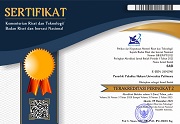Problematika Pengujian Peraturan Perundang-Undangan Di Mahkamah Agung (Kajian Terhadap Putusan Mahkamah Agung No. 65 P/HUM/2018)
 )
)
(1) Fakultas Hukum Universitas Islam Riau, Pekanbaru, Indonesia
 Corresponding Author
Corresponding Author
Abstract
Keywords
DOI
10.47268/sasi.v27i1.417
Published
2021-03-25
How To Cite
@article{SASI417,
author = {Suparto Suparto},
title = {Problematika Pengujian Peraturan Perundang-Undangan Di Mahkamah Agung (Kajian Terhadap Putusan Mahkamah Agung No. 65 P/HUM/2018)},
journal = {SASI},
volume = {27},
number = {1},
year = {2021},
keywords = {Dualism; Testing; Legislation; Constitutional Court; Supreme Court},
abstract = {The Supreme Court (MA) decided that candidates for members of the Regional Representative Council (DPD) from political party administrators for the 2019 Election were still allowed, even though previously the Constitutional Court (MK) had banned it (Decision No. This conflict is due to differences in interpreting the timing of the implementation of the ongoing 2019 Election stage process. The Constitutional Court stated that the decision was enforced since the 2019 Election and this was not retroactive. Because it is still at the Provisional Candidate List (DCS) stage, so it is possible to change regulations. Meanwhile, the Supreme Court considers that the Constitutional Court's decision must be enforced after the 2019 Election or apply in the future (prospective), because the stages have been running, so that changes in requirements can be made The legal implication that occurs is that there is legal uncertainty for the General Election Commission (KPU) to follow which decision. To solve this problem can be used the doctrine of validity (enforceability of norms). The existence of a hierarchy of legal products being tested and a basis for testing certainly has a legal consequence of the existence of a hierarchy of norm validity in the decisions of the Supreme Court and the Constitutional Court. When there is a conflict between the Supreme Court decision and the Constitutional Court, the verdict with the basis and object of examination in the hierarchy of laws and regulations that is higher, namely the Constitutional Court decision, has a higher validity than the Supreme Court decision. So that problems like this do not exist anymore, testing of laws and regulations should only be carried out by one institution, namely the Constitutional Court.},
issn = {2614-2961}, pages = {61--72} doi = {10.47268/sasi.v27i1.417},
url = {https://fhukum.unpatti.ac.id/jurnal/sasi/article/view/417}
}
[1] Abustan. (2017). Relasi Lembaga Negara Dalam Perspektif Undang-Undang Dasar Negara Republik Indonesia 1945, Unifikasi: Jurnal Ilmu Hukum, 4 (2), 55-63, https://doi.org/10.25134/unifikasi.v4i2.693.
https://doi.org/10.25134/unifikasi.v4i2.693
[2] Al-Fatih, S. (2018). Model Pengujian Peraturan Perundang-undangan Satu Atap Melalui Mahkamah Konstitusi, Legality: Jurnal Ilmiah Hukum, 25 (2), 247-260, https://ejournal.umm.ac.id/index.php/legality/article/view/6005.
https://doi.org/10.22219/jihl.v25i2.6005
[3] Alfath, T. P. (2019). Eksekutabilitas Putusan Mahkamah Agung Terhadap Pencalonan Anggota Dewan Perwakilan Daerah. Jurnal Yudisial, 12 (3), 287-303. http://dx.doi.org/10.29123/jy.v12i3.357.
https://doi.org/10.29123/jy.v12i3.357
[4] Faiz, P. M., Winata, R. M. (2019). Respon Konstitusional Larangan Calon Anggota Dewan Perwakilan Daerah Sebagai Pengurus Partai Politik. Jurnal Konstitusi, 16 (3), 532-558. https://doi.org/10.31078/jk1635.
https://doi.org/10.31078/jk1635
[5] Hardani, A., Whardani, L. T. A. L. (2019). Implementasi Putusan Mahkamah Konstitusi Nomor: 30/PUU-XVI/2018 Menurut Sistem Hukum Di Indonesia. Jurnal Pembangunan Hukum Indonesia, 1 (2), 182-193, https://doi.org/10.14710/jphi.v1i2.182-193.
https://doi.org/10.14710/jphi.v1i2.182-193
[6] Helmi, M. I. (2019). Penyelesaian Satu Atap Perkara Judicial Review Di Mahkamah Konstitusi, Salam: Jurnal Sosial dan Budaya Sar-i, 6 (1), 97-112. https://doi.org/10.15408/sjsbs.v6i1.10551.
https://doi.org/10.15408/sjsbs.v6i1.10551
[7] Mulyanto, A. (2013). Problematika Pengujian Peraturan Perundang-undangan (Judicial Review) di Mahkamah Agung dan Mahkamah Konstitusi, Jurnal Yustisia, 2 (1), 57-65. https://doi.org/10.20961/yustisia.v2i1.11070.
https://doi.org/10.20961/yustisia.v2i1.11070
[8] MD, Moh Mahfud. (2015). Titik Singgung Wewenang antara MA dan MK, Jurnal Hukum dan Peradilan, 4 (1), 1-16. http://dx.doi.org/10.25216/jhp.4.1.2015.1-16.
https://doi.org/10.25216/JHP.4.1.2015.1-16
[9] Putra, A. (2018). Dualisme Pengujian Peraturan Perundang-undangan, Jurnal Legislasi Indonesia, 15 (2), 69-79, https://e-jurnal.peraturan.go.id/index.php/jli/article/view/172.
[10] Pratiwi, L.G. (2020). Kewenangan Uji Material (Judicial Review) terhadap Ketetapan Majelis Permusyawaratan Rakyat oleh Mahkamah Konstitusi. SASI, 26 (4), 514-526. https://doi.org/10.47268/sasi.v26i4.268.
https://doi.org/10.47268/sasi.v26i4.268
[11] Sudarsono. (2017). Pengujian Peraturan Perundang-undangan Di Bawah Undang-Undang Oleh Mahkamah Agung, Jurnal Mimbar Yustitia, 1 (2), 2017, 147-169, http://e-jurnal.unisda.ac.id/index.php/mimbar/article/view/832.
[12] Satriawan, M. I., & Mukhlis, M. (2018). Memurnikan Mahkamah Konstitusi. SASI, 24 (1), 47-58. https://doi.org/10.47268/sasi.v24i1.118.
https://doi.org/10.47268/sasi.v24i1.118
[13] Sirajuddin. (2018). Desain Pengujian Peraturan Perundang-undangan Di Bawah Mahkamah Konstitusi, Jurnal Arena Hukum, 11 (2), 388-414. https://doi.org/10.21776/ub.arenahukum.2018.01002.9.
https://doi.org/10.21776/ub.arenahukum.2018.01002.9
[14] Sirajuddin., Ramadhan, F. (2019). Dualisme Pengujian Yang Berujung Tirani Keterwakilan : Kajian atas Putusan Mahkamah Agung No. 65/P/HUM/2018 dan Putusan Mahkamah Konstitusi No. 30/PUU-XVI/2018. Jurrnal Hukum Kenegaraan, 2 (1), 1-20, 16-17.
[15] Suparto, S. (2020). Kontroversi Putusan Mahkamah Konstitusi Membatalkan Kewenangan Komisi Yudisial Melakukan Rekrutmen Terhadap Hakim. SASI, 26(2), 266-279. DOI: https://doi.org/10.47268/sasi.v26i2.252.
https://doi.org/10.47268/sasi.v26i2.252
[16] Yunaldi, W. (2018). Judicial Review Satu Atap Peraturan Perundang-undangan Di Bawah Kewenangan Mahkamah Konstitusi. Pagaruyuang Law Journal, 1 (2), 198-219, https://jurnal.umsb.ac.id/index.php/pagaruyuang/article/view/565.
[17] Asshiddiqie, J., Safa'at, M. A. (2006). Teori Hans Kelsen Tentang Hukum, Jakarta: Sekretariat Jenderal dan Kepaniteraan Mahkamah Konstitusi RI.
[18] Asshiddiqie, J. (2010). Perihal Undang-Undang, Jakarta : Rajawali Pers.
| Dublin Core | PKP Metadata Items | Metadata for this Document | |
| 1. | Title | Title of document | Problematika Pengujian Peraturan Perundang-Undangan Di Mahkamah Agung (Kajian Terhadap Putusan Mahkamah Agung No. 65 P/HUM/2018) |
| 2. | Creator | Author's name, affiliation, country | Suparto Suparto; Fakultas Hukum Universitas Islam Riau, Pekanbaru; Indonesia |
| 3. | Subject | Discipline(s) | |
| 3. | Subject | Keyword(s) | Dualism; Testing; Legislation; Constitutional Court; Supreme Court |
| 4. | Description | Abstract | The Supreme Court (MA) decided that candidates for members of the Regional Representative Council (DPD) from political party administrators for the 2019 Election were still allowed, even though previously the Constitutional Court (MK) had banned it (Decision No. This conflict is due to differences in interpreting the timing of the implementation of the ongoing 2019 Election stage process. The Constitutional Court stated that the decision was enforced since the 2019 Election and this was not retroactive. Because it is still at the Provisional Candidate List (DCS) stage, so it is possible to change regulations. Meanwhile, the Supreme Court considers that the Constitutional Court's decision must be enforced after the 2019 Election or apply in the future (prospective), because the stages have been running, so that changes in requirements can be made The legal implication that occurs is that there is legal uncertainty for the General Election Commission (KPU) to follow which decision. To solve this problem can be used the doctrine of validity (enforceability of norms). The existence of a hierarchy of legal products being tested and a basis for testing certainly has a legal consequence of the existence of a hierarchy of norm validity in the decisions of the Supreme Court and the Constitutional Court. When there is a conflict between the Supreme Court decision and the Constitutional Court, the verdict with the basis and object of examination in the hierarchy of laws and regulations that is higher, namely the Constitutional Court decision, has a higher validity than the Supreme Court decision. So that problems like this do not exist anymore, testing of laws and regulations should only be carried out by one institution, namely the Constitutional Court. |
| 5. | Publisher | Organizing agency, location | Faculty of Law, Universitas Pattimura |
| 6. | Contributor | Sponsor(s) | |
| 7. | Date | (YYYY-MM-DD) | 2021-03-25 |
| 8. | Type | Status & genre | Peer-reviewed Article |
| 8. | Type | Type | |
| 9. | Format | File format | PDF, XML |
| 10. | Identifier | Uniform Resource Identifier | https://fhukum.unpatti.ac.id/jurnal/sasi/article/view/417 |
| 10. | Identifier | Digital Object Identifier | 10.47268/sasi.v27i1.417 |
| 11. | Source | Title; vol., no. (year) | SASI; Vol 27, No 1 (2021): Volume 27 Nomor 1, Januari - Maret 2021 |
| 12. | Language | English=en | en |
| 13. | Relation | Supp. Files | |
| 14. | Coverage | Geo-spatial location, chronological period, research sample (gender, age, etc.) | |
| 15. | Rights | Copyright and permissions | Copyright: Authors who publish their manuscripts in this Journal agree to the following conditions: 1. The copyright in each article belongs to the author, as well as the right to patent. 2. Authors can enter into separate, additional contractual arrangements for the non-exclusive distribution of the journal's published version of the work (e.g., post it to an institutional repository or publish it in a book), with an acknowledgment of its initial publication in this journal. 3. Authors are permitted and encouraged to post their work online (e.g., in institutional repositories or on their website) before and during the submission process, as it can lead to productive exchanges, as well as earlier and greater citation of published work. 4. Authors have the right to self-archiving of the article (Author Self-Archiving Policy)
License: The SASI Journal is disseminated based on the Creative Commons Attribution-NonCommercial 4.0 International license terms. This license allows anyone to copy and redistribute this material in any form or format, compose, modify, and make derivatives of this material for any purpose. You cannot use this material for commercial purposes. You must specify an appropriate name, include a link to the license, and certify that any changes have been made. You can do this in a way that is appropriate but does not imply that the licensor supports you or your use.
|
Copyright (c) 2021 Suparto Suparto

This work is licensed under a Creative Commons Attribution-NonCommercial 4.0 International License.

 : 3640 times
: 3640 times Download : 3397 times
XML
Download : 3397 times
XML 















